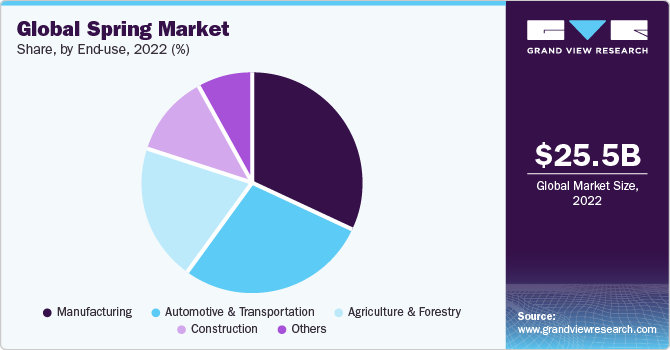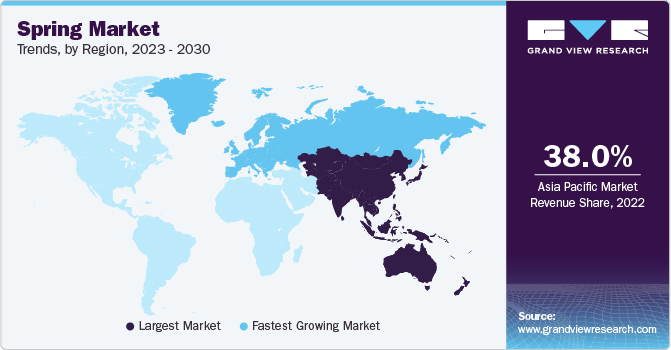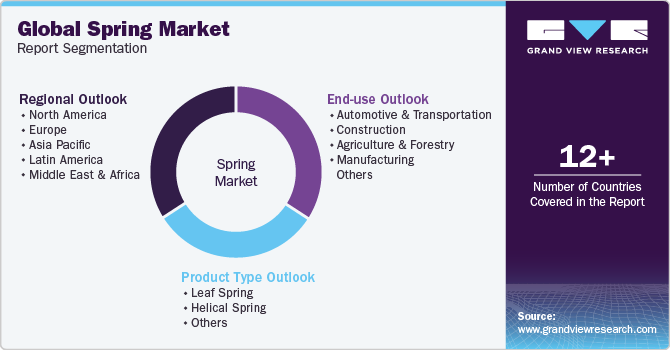- Home
- »
- Communications Infrastructure
- »
-
Spring Market Size, Share, Growth & Trends Report, 2030GVR Report cover
![Spring Market Size, Share & Trends Report]()
Spring Market Size, Share & Trends Analysis Report By Product Type, By End-use (Automotive & Transportation, Construction, Agriculture & Forestry, Manufacturing), By Region, And Segment Forecasts, 2023 - 2030
- Report ID: GVR-4-68038-200-6
- Number of Report Pages: 83
- Format: PDF, Horizon Databook
- Historical Range: 2017 - 2021
- Forecast Period: 2023 - 2030
- Industry: Technology
Spring Market Size & Trends
The global spring market size was valued at USD 25.53 billion in 2022 and is expected to grow at a compound annual growth rate (CAGR) of 5.0% from 2023 to 2030. The increasing demand for springs across various end-use verticals, such as automotive, manufacturing, agriculture, and forestry, will drive the market over the forecast period. Also, there are no other components available to replace the utility of springs, and hence, the springs are widely used across all the verticals. Furthermore, growing development and adoption of manufacturing methods, such as the shift from manual manufacturing to automated drive and robotic arm, is also expected to support the growth of the market.

Manufacturing of springs from lightweight and high-strength metals and alloys to reduce weight and increase strength has also increased the application of springs in aircraft, satellite, and automobile manufacturing. As a large number of springs are used in automotive and aircraft, a reduction in the weight of springs will decrease the overall weight of the structure and increase the structure’s load caring capacity. In automobiles and aircraft, springs are also used in the suspension system, brake system, and interiors to facilitate the opening and closing of many components, such as doors and armrests. Moreover, springs are also used in a wide range of integral components, including actuators, engines, and fuel pumps.
The initial cost of set-up for the manufacturing of springs is low and requires moderate capital investment with a good return on investment due to significant demand. It has attracted many vendors towards investing in the market, providing easy entry to the new entrants in the market. Also, the rising automation in various industries has significantly raised the machining methods to optimize the production processes.
It is done to increase the production capacity to cater to the ever-increasing demand for spring from the end users. Innovative machining methods (use of Cad and Cam) are now capable of manufacturing springs with complex geometries from different alloys. These alloy springs are lighter in weight and offer longer work life than conventional springs.
The presence of a large number of domestic and international participants in this market has made the market highly competitive. Also, export contributes to a substantial share of the market, owing to which the market is highly susceptible to the growth of other economies as well.
Hence, a decline in demand from importing economies can negatively impact exports as well as export-oriented industries.
Springs form a vital component in automobiles. Different types of springs are used in the suspension systems and braking systems of both passenger vehicles and light, medium, and heavy-duty commercial vehicles. While the main application of the springs is to release the stored energy, different types of springs, including helical springs, leaf springs, compression springs, spiral springs, and coil springs, are installed in automobiles depending upon the application. Given the fact that there is hardly any practical replacement for springs when it comes to automotive applications, the growth of the automotive industry is expected to drive the demand for springs required in various automotive applications.
The primary function of springs is to absorb shocks and reduce the mass of the assembled structure. Hence, springs form a vital component in automobiles. However, as the application portfolio of springs continues to widen, the need for different types of springs is growing. As such, different types of springs, such as lightweight springs, corrosion-resistant springs, and springs with high fatigue life, are being manufactured according to the changing needs of various end-use industries and industry verticals. At this juncture, spring manufacturers have realized that advanced, state-of-the-art technology would be required to design springs with precision and cater to the evolving requirements of the end users. CAD/CAM systems are being used aggressively to design complex springs.
The widening application portfolio of springs is driving the demand for different types of springs, such as leaf springs, coil springs, flat springs, and composite springs. However, these springs need to be tailored to the specific requirements of different end-use industries and industry verticals. Manufacturing springs requires high precision. Selection of defective materials, deficiencies in design, and errors in manufacturing can lead to spring failures, particularly if the springs are unable to take the desired loads and fatigue. At this juncture, the manufacturing of springs needs to be done with a proper understanding of the end-use application, and corrosion-resistant, lightweight materials with high fatigue life need to be selected accordingly. Durability, flexibility, strength-to-weight ratio, load-carrying ability, vibration and shock absorption capability, and friction resistance are some of the parameters that need to be considered while designing and manufacturing springs.
Product Type Insights
The helical spring segment accounted for the largest revenue share of 52.7% in 2022 and is expected to grow at the fastest CAGR during the forecast period. The high demand for helical springs is attributed to their advantages, such as coil structure. For instance, in shock absorbers, a specific type of helical structure is used. These springs enable energy storage when pressed because of resilient force, and then this energy is subsequently released, providing comfort to the passenger riding the automobile even on uneven surfaces. Other benefits offered by this type include resisting the pull forces between two or more objects, making it suitable for various applications such as carburetors and drum brakes. Helical springs are known for the excellent absorption of shocks and sudden impacts, which are crucial for the automotive, aerospace, and railways industries.
The leaf spring segment is expected to witness a significant CAGR during the forecast period owing to its increasing demand in various end-use industries such as railways and automotive. Leaf spring helps maintain the good health of the vehicle and the safety of the passengers by isolating the vibrations produced due to road disturbances from transferring to the driver and passengers. The escalating demand for automobiles in developing countries, coupled with an increasing focus of automobile original equipment manufacturers on improving passenger safety and comfort, is anticipated to fuel segment growth. Also, the shifting preference of people towards electric vehicles has led to an increased demand for springs from electric vehicle manufacturers, which is expected to impact the market over the forecast period positively.
End-use Insights
Manufacturing accounted for the largest revenue share of 31.6% in 2022, owing to a wide range of applications such as robotics and automated drives. Rapidly changing manufacturing technology, such as the use of CNC (computer numerical control) machines, frequent innovation of springs in terms of design and materials, and adoption of customized product manufacturing, have accelerated the growth of the segment. Springs offer high flexibility and can be customized to meet user-specific requirements

The automotive and transportation segment is expected to grow at the fastest CAGR of 5.9% during the forecast period. This is due to the fact that automobiles highly rely on springs to withstand surface conditions (rough, uneven terrain). Also, electric vehicles have been witnessing significant growth due to the growing need to address future energy requirements. For instance, according to the International Energy Agency in 2022, the global electric vehicle car sales exceeded more than 10 million units from 6 million in 2021.
Regional Insights
Asia Pacific dominated the market and accounted for the largest revenue share of 38.0% in 2022. Increased demand for spring from the automobile, transportation, and manufacturing sectors is owing to the development of manufacturing facilities by industry leaders in this region. China is estimated to commence the operations of the largest production facilities of automobile spare parts on account of the easy availability of raw materials and labor in the country.

Europe is expected to grow at the fastest CAGR of 5.6% during the forecast period, owing to the presence of established automobile, aerospace, and defense manufacturers in the region. Ascending demand for electric vehicles in European countries has boosted electric vehicle production, impacting the growth of the market in the region. Additionally, growth in the aerospace and defense sector in countries such as France and the U.K. is also expected to boost the market over the forecast period.
The U.K. and France are expected to grow at a considerable growth rate, respectively, on account of the rising adoption of state-of-the-art machining methods and increasing demand for springs to support continued automation across various industry verticals. The presence of several electric vehicle manufacturers across the U.K. and France is expected to play a vital role in driving the growth of the market. Also, the rising development of the aerospace and defense industry in the U.K. and France bodes well for the growth of the spring market.
Key Spring Company Insights
The players are focusing on the formation of long-term agreements and strategic alliances with other manufacturers as well as OEMs to dilute or eliminate the risks and increased costs associated with the development of new automotive products. For instance, in May 2021, Hexion and Rassini collaborated to implement composite leaf springs in Ford's next F-150 pickup. Rassini created a hybrid rear suspension with a composite assist and a parabolic primary steel leaf.
Industry participants are also involved in the research and development of new springs with lighter weight and higher-pressure resistant capability to decrease the overall weight of the automobile, reduce the overall emission, and increase the efficiency of the automobile. Moreover, there is a high demand for lightweight springs in the aerospace and defense sector to decrease the overall weight of the aircraft and increase its load-carrying capacity.
Key Spring Companies:
- GALA GROUP
- Ace Wire Spring & Form Company
- Bal Seal Engineering.
- Barnes
- CARL HAAS GmbH
- EBSCO Spring Co.
- FRAUENTHAL HOLDING
- Hendrickson USA, L.L.C.
- Ifc Composite Gmbh
- JAMNA AUTO INDUSTRIES LIMITED.
- John Evans’ Sons Inc.
- Muhr and Bender KG
- Rassini.
- Sogefi SpA
Recent Developments
-
In May 2022, DONGFENG MOTOR RUS LLC launched a truck in Russia. The DF6 is a pickup truck with a frame that is comfortable, reliable, and capable of going off-road. The sturdy undercarriage, which has a rear-dependent leaf spring and a double-wishbone front suspension, is appropriate for Russian roads.
Spring Market Report Scope
Report Attribute
Details
Market size value in 2023
USD 26.64 billion
Revenue forecast in 2030
USD 37.53 billion
Growth Rate
CAGR of 5.0% from 2023 to 2030
Base year for estimation
2022
Historical data
2017 - 2021
Forecast period
2023 - 2030
Quantitative units
Revenue in USD million/billion and CAGR from 2023 to 2030
Report coverage
Revenue forecast, company ranking, competitive landscape, growth factors, and trends
Segments covered
Product type, end-use, region
Regional scope
North America; Europe; Asia Pacific; Latin America; MEA
Country scope
U.S.; Canada; UK; Germany; France; China; Japan; India; Australia; South Korea; Brazil; Mexico; Saudi Arabia; South Africa; UAE
Key companies profiled
GALA GROUP; Ace Wire Spring & Form Company; Bal Seal Engineering.; Barnes; CARL HAAS GmbH; EBSCO Spring Co.; FRAUENTHAL HOLDING; Hendrickson USA, L.L.C.; Ifc Composite Gmbh; JAMNA AUTO INDUSTRIES LIMITED.; John Evans’ Sons Inc.; Muhr and Bender KG; Rassini.; Sogefi SpA
Customization scope
Free report customization (equivalent up to 8 analyst’s working days) with purchase. Addition or alteration to country, regional & segment scope
Pricing and purchase options
Avail customized purchase options to meet your exact research needs. Explore purchase options
Global Spring Market Report Segmentation
This report forecasts revenue growth at global, regional, and country levels and provides an analysis of the latest industry trends in each of the sub-segments from 2017 to 2030. For this study, Grand View Research has segmented the global spring market based on product type, end-use, and region:

-
Product Type Outlook (Revenue, USD Million, 2017 - 2030)
-
Leaf Spring
-
Helical Spring
-
Others
-
-
End-use Outlook (Revenue, USD Million, 2017 - 2030)
-
Automotive and Transportation
-
Construction
-
Agriculture & Forestry
-
Manufacturing
-
Others
-
-
Regional Outlook (Revenue, USD Million, 2017 - 2030)
-
North America
-
U.S.
-
Canada
-
-
Europe
-
UK
-
Germany
-
France
-
-
Asia Pacific
-
China
-
Japan
-
India
-
Australia
-
South Korea
-
-
Latin America
-
Brazil
-
Mexico
-
-
Middle East and Africa
-
Saudi Arabia
-
South Africa
-
UAE
-
-
Frequently Asked Questions About This Report
b. The global spring market size was estimated at USD 25.53 billion in 2022 and is expected to reach USD 26.64 billion in 2023.
b. The global spring market is expected to grow at a compound annual growth rate of 5.0% from 2023 to 2030 to reach USD 37.53 billion by 2030.
b. Asia Pacific dominated the spring market with a share of 38% in 2022. This is attributable to the increased demand for spring from the automobile, transportation, and manufacturing sectors.
b. Some key players operating in the spring market include GALA GROUP; Ace Wire Spring and Form Co., Inc.; Bal Seal Engineering, Inc.; Barnes Group Inc. (Associated Spring); CARL HAAS GmbH; EBSCO Spring Co.; Frauenthal Holding AG; Hendrickson Usa L.L.C.; Ifc Composite Gmbh; Jamna Auto Industries Ltd.; John Evans Sons Incorporated; Mubea Tellerfedern GmbH; Rassini SAB de CV; and Sogefi SpA.
b. Key factors that are driving the market growth include the increasing demand for springs across various end-use verticals such as automotive, manufacturing, agriculture, and forestry.
Share this report with your colleague or friend.
![gvr icn]()
NEED A CUSTOM REPORT?
We can customize every report - free of charge - including purchasing stand-alone sections or country-level reports, as well as offer affordable discounts for start-ups & universities. Contact us now
![Certified Icon]()
We are GDPR and CCPA compliant! Your transaction & personal information is safe and secure. For more details, please read our privacy policy.
We are committed towards customer satisfaction, and quality service.
"The quality of research they have done for us has been excellent."





